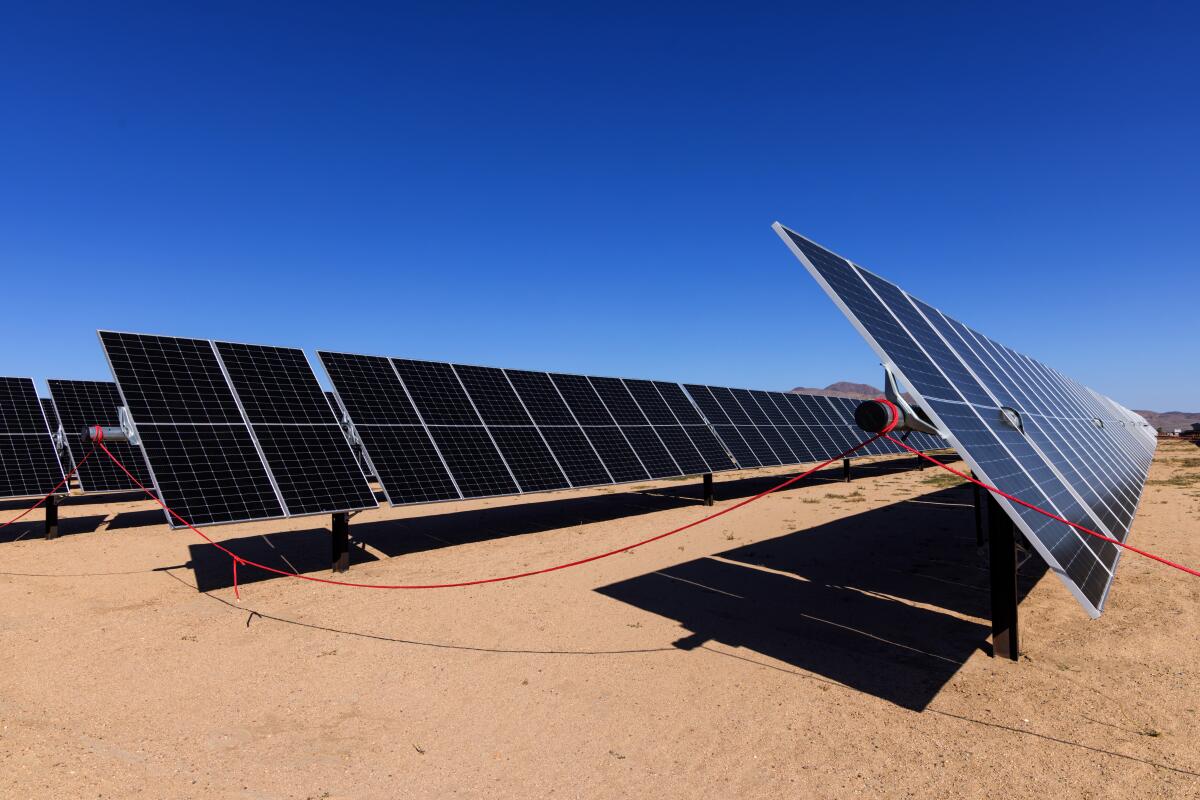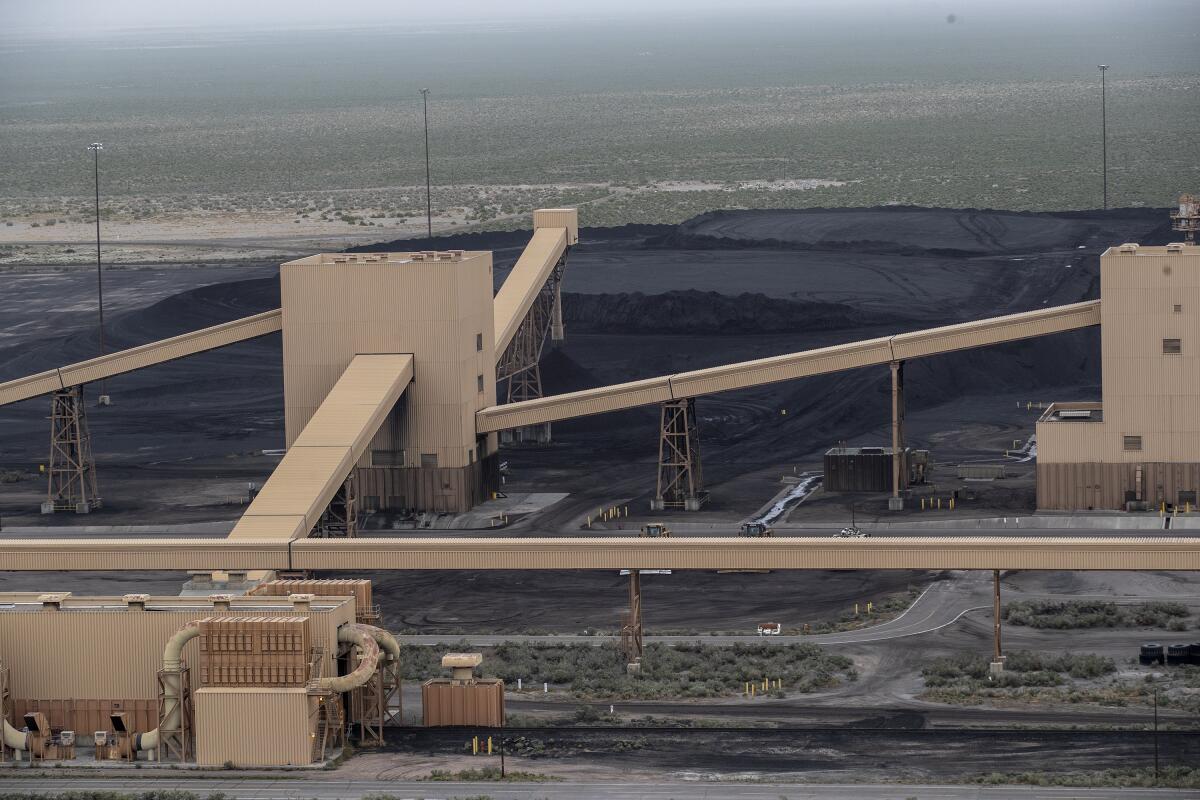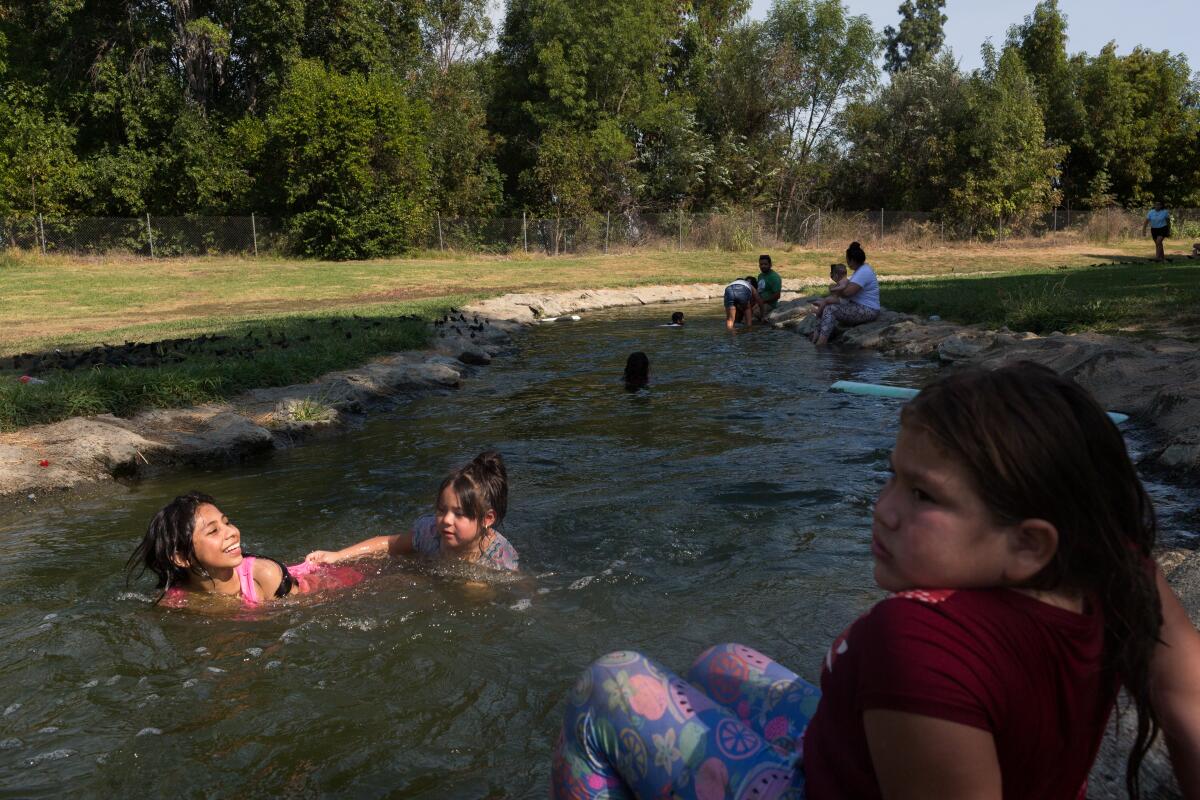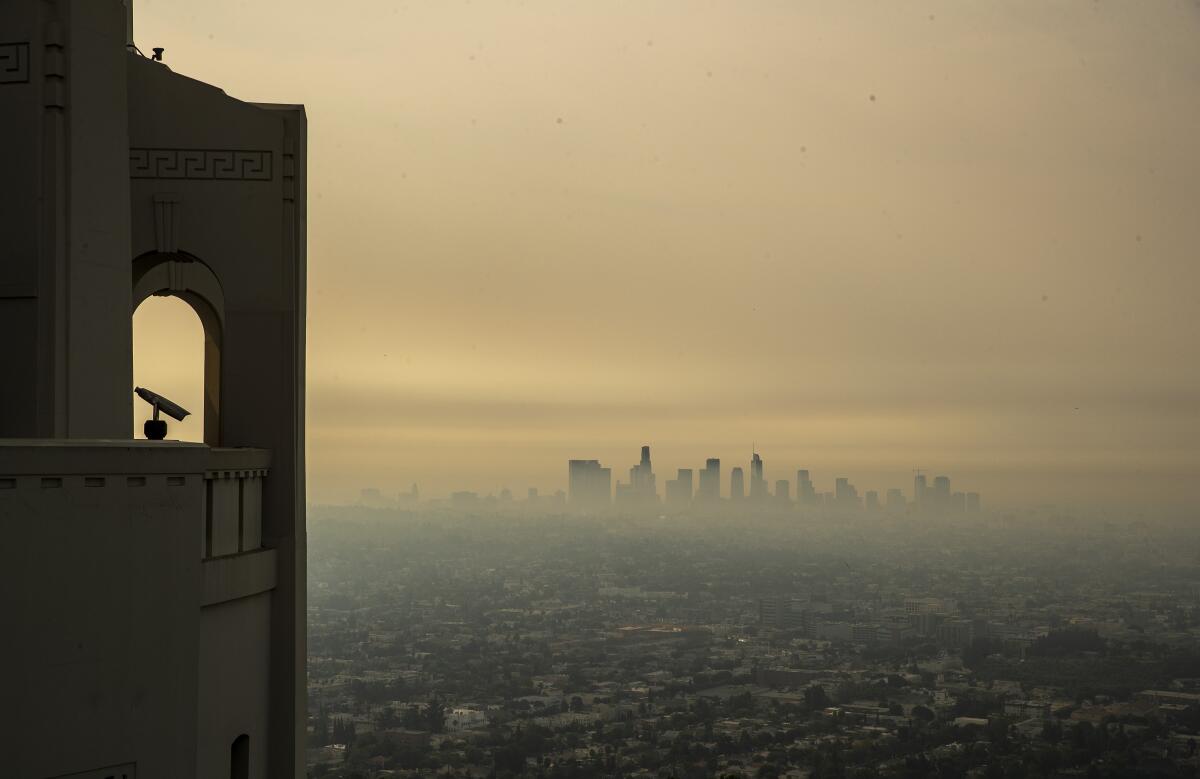Column: Solving climate change will have side effects. Get over it

- Share via
When I wrote a column two weeks ago urging the Biden administration to approve a lot more solar and wind farms on Western public lands, I knew I would get flak from critics of large-scale renewable energy — and indeed I did.
On social media, conservationists blasted me for what they described as my failure to understand that sprawling solar projects and towering wind turbines tear up wildlife habitat and destroy treasured landscapes. They called me a shill for money-grubbing utility companies and suggested it’s obvious that we should rebuild our energy systems around solar panels on rooftops.
I’m sympathetic to those arguments and want to clarify where I’m coming from.
I’m familiar with the science showing that human survival depends in part on limiting further biodiversity loss and protecting much of the remaining natural world. I feel a deep appreciation for America’s spectacular public lands; I’ve hiked and camped across the West, from the Teton Crest Trail to Mt. San Jacinto. I’d love to see more national monuments created.
In an ideal universe, I’d support building renewable energy exclusively within cities and on previously disturbed lands such as farm fields and irrigation canals. In an ideal universe, I’d support only climate solutions that don’t cause other problems.
But we don’t live in an ideal universe.
We live in a universe where every clean energy technology has drawbacks, whether economic or technical or political. A universe where there aren’t enough rooftops to replace all the fossil fuels we now burn. Where skeptical farmers are fighting to stop their neighbors from switching to solar energy production. Where building solar on canals is wildly expensive, at least so far.
Just as importantly, we live in a universe where human beings use mind-boggling amounts of energy.
Every time we flip a light switch, run the dishwater or take a drive, we’re using energy. Our coffee mugs, our clothes, our homes — they took energy to manufacture. Same with the food we eat, the TV shows we love and our favorite board games.
Even with aggressive energy-efficiency improvements, we’ll need an unprecedented solar and wind building spree to replace all the coal, oil and fossil natural gas boiling the planet and spewing toxic fumes responsible for millions of deaths each year.

So why have we had so much trouble coalescing around the need for a broad range of clean energy technologies?
If you ask me, it’s because it’s so hard to grapple with the enormity of the climate crisis.
Deadlier heat waves, bigger wildfires, shrinking reservoirs, rising oceans — we understand them on paper. But most of the time they’re abstract, lurking in the background. Whereas a wind farm that will kill golden eagles is tangible, easy to grasp. Same with a solar farm that will be visible from Joshua Tree National Park, or an electric line that will cut through ancient burial sites.
It’s not wrong to care about that stuff. It’s not wrong to want to protect the places we know and love.
But too many of us have gotten stuck looking at the world through a narrow defining lens.
Mistrustful of monopoly utility companies? Then you probably see rooftop solar panels as the ideal climate change solution. Live near the coast and love the ocean views? Then solar farms in the desert probably sound better than offshore wind turbines. Find it easier to cope with the idea of climate chaos if you can convince yourself a single technology or policy will fix everything? Then maybe you’re a devotee of nuclear reactors, or a carbon fee, or carbon capture and storage.
If we were having this conversation a few decades ago — say in 1988, after climate scientist James Hansen testified to Congress that global warming had arrived — then debating the best suite of climate solutions might be a good use of time. We could work together to reach consensus on the right path forward and ensure the side effects were as painless as possible.
But this is 2023, not 1988.
Largely thanks to the fossil fuel industry’s climate denial and the Republican Party’s continued intransigence, we’re out of time. I keep saying this in my columns, but it bears repeating: Scientists have calculated we need to cut global climate pollution nearly in half by 2030, just seven years from now, to avoid an extremely scary future. Seven years is nothing. This is an emergency.
Much as I hate the idea of paving over desert tortoise habitat with solar panels or refusing to remove dams that have decimated salmon populations, I hate the idea of 3 degrees Celsius of planetary warming a lot more. Much as I sympathize with rural towns that don’t want to live with industrial wind turbines as their neighbors, I sympathize more with my neighbors here in Los Angeles who can’t afford air conditioning and don’t want to die of heatstroke the next time the thermostat hits 121 degrees.

For those of you reading this with frustration — I realize I’m probably not going to convince you. You don’t know why I can’t just understand that your climate solution is the best one, and use my platform as a journalist to help bring it about.
My unsatisfying response is that I’m a realist.
I know that not every proposed clean energy solution is a good idea. But the reality is that solar farms and wind turbines, for all their faults, are some of the most proven, cost-effective, politically popular tools for reducing our reliance on fossil fuels.
I could spend all my time singing the praises of rooftop solar — which I did last week, by the way — and it wouldn’t change the fact that avoiding the worst consequences of climate change will be a hell of a lot easier if we embrace big solar and wind.
Now, for those of you reading this and nodding in agreement — thanks for your support. But I hope you’ll stop and ask yourself: What are you personally willing to sacrifice to bring about a safe climate future? What changes will you make in your life?
Will you eat less meat, replace your gas stove with an induction cooktop or lease an electric car? Will you make climate change a top priority at the ballot box, and post about it on Instagram, and bring it up at the dinner table on Thanksgiving?
If you hear about a climate solution that rubs you the wrong way, will you swallow hard and look the other way?
Because that’s what it’s going to take.
To maintain a habitable planet for ourselves and our children and grandchildren, we’ll need to make some compromises. We’ll need to stand by and watch as some pristine ecosystems are razed in the name of renewable energy. We’ll need to learn to live with exorbitantly wealthy investors raking in additional profits at our expense. We’ll need to elect some politicians whose ideas don’t fully line up with our own, because they’re nonetheless our best hope of avoiding planetary collapse.
Above all, we’ll need to stop yelling at each other and start cooperating with people we think are wrong.
That’s the world we live in. Welcome to the Anthropocene.
And now, here’s what’s happening around the West:
TOP STORIES

This past Friday and Saturday were 2 degrees Celsius hotter than Earth’s preindustrial average — the first times we’ve crossed a climate threshold that scientists have long urged us to avoid. Two days at that level doesn’t mean we can’t still avoid longer-term warming above 2 degrees. But they do serve as an urgent reminder that we can’t keep wasting time, experts told my colleague Hayley Smith. And even if we ultimately fail to limit warming to 2 degrees, every barrel of fossil fuel that we don’t burn makes a difference. As climate scientist Katharine Hayhoe told Hayley and The Times’ Ian James for their important story on the latest U.S. climate report, “Every 10th of a degree of warming matters. Every bit matters.”
The Los Angeles Department of Water and Power is out with a new analysis showing how much more it must do to bring clean energy to low-income communities and people of color. Hayley Smith wrote about the report, which found that just 23% of the city’s electric vehicle investments, 38% of its solar projects and 46% of its home energy-efficiency incentives have gone to disadvantaged communities. For an example of how climate action can help those communities, see this piece by Oakland Voices’ Momo Chang about a California program bringing rooftop solar to an affordable housing complex for Oakland seniors. (See also my column from last week about Gov. Gavin Newsom’s appointees slashing rooftop solar incentives for apartment renters.)
On a Northern California farm, a Black naturalist is working to use African American heritage to help usher humanity through the climate crisis. Here’s the powerful story, from The Times’ Tyrone Beason, about EARTHseed Farm and its founder, Pandora Thomas. “People look to Black culture for what’s the newest music, hairstyle or fashion trend,” she says. “Imagine if they looked to our communities for what’s the newest trend for how we should be living around climate practices and environmental practices. What can we garner from the past that we can bring to this moment to help us plot a better future?”
THE ELECTRIC GRID
California officials voted to let Pacific Gas & Electric bury 1,230 miles of power lines — a multibillion-dollar investment that should help reduce wildfire ignition risk but will also contribute to PG&E customers paying an average of $32 more per month. The company had asked for an even bigger rate increase to pay for burying even more power lines, the Associated Press’ Adam Beam writes. Electric rates are already frustratingly high, but this type of investment is almost certainly necessary — just last week, Cal Fire concluded that a Southern California Edison power line helped spark the 2022 Fairview fire, which killed two people, the Washington Post’s Vanessa Montalbano and Brianna Sacks report. In related news, the California Supreme Court just ruled that PG&E can’t be sued for shutting off power to prevent wildfire ignitions, my colleague Kevin Rector reports.
The Biden administration is rolling out $169 million from the Inflation Reduction Act to support manufacturing of electric heat pumps — a crucial tool for replacing gas heating in our homes and businesses. Details here from Wired’s Matt Simon. In addition to slashing climate pollution from gas boilers, heat pumps can help protect us from volatile natural gas prices. Speaking of which, if you’re a Southern California Gas customer worried about gas prices rising sharply again this winter, you can sign up to get text message warnings from SoCalGas, The Times’ Karen Garcia reports.
Will a quietly approved new law help California build out the power grid as fast as we need to support millions of electric cars, heat pumps and stoves? Senate Bill 410, which was signed by Gov. Gavin Newsom last month, hadn’t sounded like that big of a deal to me. But this deep dive by Canary Media’s Jeff St. John makes a compelling case that the law could go a long way.
100% CLEAN ENERGY

The Gila River Indian Community is moving ahead with the first U.S. project to cover part of an irrigation canal with solar panels. There are still high costs and technical barriers to overcome before solar on canals can become a significant piece of the push for 100% clean energy. But this first-of-its-kind project is a big step forward, the Arizona Mirror’s Shondiin Silversmith writes. In another example of an innovative project to limit environmental damage from renewable energy, California now has its second small solar-plus-storage plant featuring used electric car batteries, as Kavya Balaraman reports for Utility Dave.
The Bill Gates-backed company making plans for a small nuclear power plant in Wyoming insists the cancellation of a similar nuclear project in Idaho does not portend its doom. WyoFile’s Dustin Bleizeffer explained what makes TerraPower’s “small modular reactor” proposal different from the one that failed in Idaho, while also talking with critics who see nothing but trouble for the Gates-funded startup. Here in Southern California, meanwhile, dismantling of the shuttered San Onofre nuclear plant is more than 60% complete, per the San Diego Union-Tribune’s Rob Nikolewski. But the iconic San Onofre domes — which you may have seen driving between L.A. and San Diego, just off the 5 Freeway — probably won’t start coming down until 2026.
Portugal just ran on 100% clean energy for six days in a row. Yes, it’s possible. Canary Media’s Julian Spector explains how.
ROADS AND RIVERS
Last week’s brief closure of a portion of the 10 Freeway through downtown Los Angeles set off a panic. Now why can’t the freeway system’s role in fueling the climate crisis do the same? My colleague Ryan Fonseca wrote about the need to invest in public transit good enough that people will want to stop driving on traffic-clogged, polluting highways. The Times’ editorial board weighed in as well, writing about the surprising speed with which public agencies were able to repair the 10 last week. “There are countless other transit, pedestrian and safe-streets projects that deserve a similar sense of urgency,” the editorial board wrote.
Can Southern California’s mountain towns survive climate change? That’s the question posed in this harrowing story by my colleagues Grace Toohey, Summer Lin and Nathan Solis, about the unprecedented winter storms that wreaked havoc in the San Bernardino Mountains earlier this year — the kind of storms getting worse with more fossil fuel pollution. In another reminder of the dangers, Grace also wrote about a new report finding that heavy winter rains caused a landslide that destroyed eight homes in the Los Angeles County city of Rolling Hills Estates. Farther north, a stretch of California’s iconic Highway 1 remains closed 10 months after it was battered by winter storms, The Times’ Thomas Curwen reports.
The Eel River is on track to become California’s longest free-flowing waterway, as Pacific Gas & Electric formalizes a plan to tear down two dams to clear the way for salmon passage. Mary Callahan has the story for the Santa Rosa Press Democrat, writing that PG&E’s plan “fulfills long-held dreams of conservationists and fishery groups to see the cold, clear headwaters of the Eel River, part of the Mendocino National Forest, reopened to migrating fish and to restore natural river flows.”
ONE MORE THING

There’s nowhere we can go to escape the realities of climate change — not even Disneyland.
“The next generation’s theme parks will need to minimize the walking space between attractions. That space will need to be filled with shady trees and cooling landscaping, not cheap concrete and tarmac,” theme park expert Robert Niles writes for the Orange County Register. “Waiting, dining and shopping areas will need to be indoors, or at least covered and cooled.”
Niles’ column is a high-level look at what Disneyland, Knott’s Berry Farm, Universal Studios Hollywood and other theme parks might need to do to stay safe and comfortable for customers as the planet heats up and weather gets more extreme.
“Bad weather is the design challenge that will determine the industry’s future,” Niles writes.
As a big Disneyland fan, I hope that is a challenge someone accepts.
This column is the latest edition of Boiling Point, an email newsletter about climate change and the environment in California and the American West. You can sign up for Boiling Point here. And for more climate and environment news, follow @Sammy_Roth on X.
Toward a more sustainable California
Get Boiling Point, our newsletter exploring climate change, energy and the environment, and become part of the conversation — and the solution.
You may occasionally receive promotional content from the Los Angeles Times.




